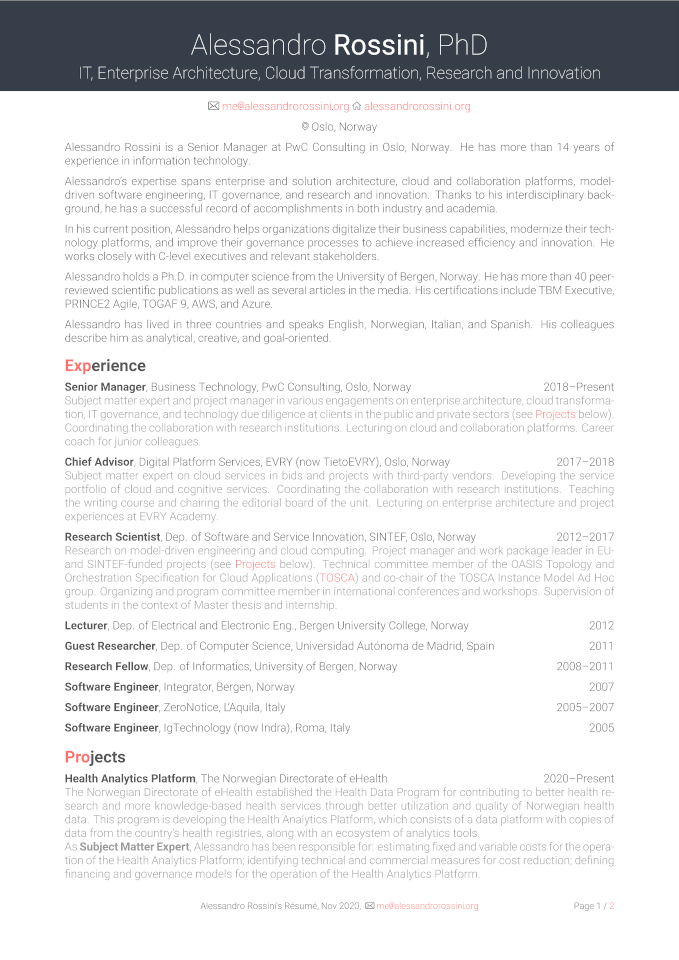Adaptive CV allows to compile different variants of a CV (e.g., a résumé and an extended CV) from a single LaTeX source. It is particularly suitable for academic CVs but flexible enough to be used with any CVs.
Adaptive CV requires XeTeX along with the array, biblatex, csquotes, enumitem, fancyhdr, fontspec, geometry, hyperref, longtable, parskip, tikz, totpages, and xcolor LaTeX classes.
The extended class option prints the content within the \ifextended…\fi blocks.
The online class option prints the email address with a bitmap @ and . symbols to prevent email spam, and does not print the street address, the postal code, and the telephone number to preserve privacy.
The print class option prints the CV in grayscale.
The ISO 639-1 language code (e.g., en, default) class option prints the CV using the corresponding language definition file (e.g., adcv_en.def, default). Currently, only the official languages of the European Union plus Norwegian are supported.
The \adcvname{<first name>}{<last name>} command defines the first and last names.
The \adcvtitle{<title>} command defines the title.
The \adcvaddress{<street address>}{<postal code>}{<locality name>}{<country name>} command defines the visiting address.
The \adcvphone{<phone number>} command defines the phone number.
The \adcvemail{<local name>}{<second-level domain>}{<top-level domain>} command defines the email address.
The \adcvwebsite{<URL>}{<link name>} command defines the website URL.
The \adcvdate{<date>} command defines the date of the last update. The day-month-year date format is recommended outside the USA.
The adcvtabletwo environment provides a generic table with a wide left column and a narrow right column.
The \adcvrowtwo{<left column text>}{<right column text>} command prints a row of the generic table with text in the left column and text in the right column.
The \adcvrowmulti{<text>} command prints a row of the generic table with text spanning across the left and right columns.
The \adcvrowskip command skips a row.
The adcvlanguages environment provides a language proficiency table based on the Common European Framework of Reference for Languages (CEFR).
The \adcvmothertongue{<language name>} command prints the mother tongue.
The \adcvlanguagesheader command prints the header of the language proficiency table.
The \adcvlanguage{<footnote number> (optional)}{<language name>}{<listening level>}{<reading level>}{<interaction level>}{<production level>}{<writing level>} command prints a row in the language proficiency table.
The \adcvAOne…\adcvCTwo commands print the A1…C2 proficiency levels, respectively.
The \adcvlanguagesfooter command prints the footer of the language proficiency table.
The \adcvlanguagesfootnote{<footnote number>}{<footnote text>} prints a footnote under the language proficiency table.
The adcvpresentations environment provides a presentation enumeration.
The \adcvpresentation{<title>}{<conference>} prints an item in the presentation enumeration with the title in the first row and the conference in the second row.
Copyright 2016-2017 Alessandro Rossini.
This work may be distributed and/or modified under the conditions of the LaTeX Project Public License (LPPL) version 1.3 or later.
This work consists of the files adcv.cls, adcv_en.def, bib_alessandro_rossini.bib, and cv_alessandro_rossini_en.tex.
Adaptive CV is inspired by Friggeri CV and Europe CV. It uses the Roboto fonts and the Multimedia Collection icons.
